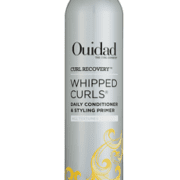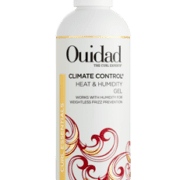Quiz! How Well Versed are you in Curl Talk?
Ever heard someone refer to their hair as “CG” and wonder what does that even mean? Well, in the same way every country has their own language(s), curly hair has its own too. We use this jargon to refer to different things like the current state of our hair to the style we did overnight to protect it. It works for those with curls and makes conversation much simpler. Take our quiz and see how you rank with your curly lingo. Give your self a point for each term you know:
Wash-and-go: This is any time you wash your hair for the first time. A wash-and-go is your hair in its cleanest, freshest state, which takes place on the first day. Once you reach Day 2 and refresh it, it is no longer a wash-and-go.
Second-day hair: Most people with curly hair prefer second day hair because it has already stretched out by this point and it looks more natural than first-day hair. In order to achieve successful second day hair results, you must use an effective overnight method to ensure your day 2 hair looks poppin’.
Day 3 hair: This is your hair after the second day. Third-day hair can be do or die because it might start to get dirty or you sweated it out so you have to decide if you want to wash again or refresh. Most can make it up to day 3 even day 4, it’s just a matter of how you wrap your hair overnight and how you refresh it.
Twist-out: This style is most common in those who have tighter curl patterns because they hold the style more. Twist-outs are usually an overnight protective method that also give your curls a different look when you untwist them. They’re simple- you take two even strands of hair and twist them together. Add conditioner or styling cream beforehand and make sure your hair is damp for good results.
Braid-out: A braid-out is similar to a twist-out, just with braids. You will repeat the same method and your curls will have an “S” shape when released. Most common within kinkier curl types.
CG: Curly Girl method is an approach to hair care designed for naturally curly hair that has not been relaxed. It is similar to the “no poo” method in that it discourages the use of shampoo. Among other things, it calls for the use of conditioner in place of shampoo (also called “conditioner washing” or “co-washing”), no silicones (used in many commercial conditioners and styling products), no blowdrying, and no combs, brushes, or terrycloth towels.This method works great for low porosity textures.
Finger Coiling: Finger coiling is most effective when done right after a wash and styling product is applied. For the best results, take even strands of your hair and use your index finger to twirl them. If you twirl them too much, your curls will struggle with volume. Try to twirl them gently and not too far so they can look more natural.
Pineapple: A common overnight style to protect your curls. The pineapple is achieved by using a large wrap or bandana, folding it diagonally, flipping your hair forward, and tying it in the front. It is then up to you if you want to leave the front of your hair out or use the front of the wrap to tuck it in. Some people don’t like to pineapple because they feel it flattens out their hair too much.
Protective style: Any style that differs from a wash-and-go but still protects your hair. Examples of protective styles are: wearing wraps, box braids, slick back buns and wigs. These styles are recommended for those who want to give their curls a break and try something new. Keep in mind that blowing out your hair is NOT a protective hairstyle!
Sulfate-free products: Products that do not contain the harsh detergents that can dry up your hair or strip its color. Always check the labels and ingredients of a product before purchase- if you have colored hair it is imperative you stay away from sulfates!
Raking method: A method used after applying a styling product. Use your fingers and have them act like a comb and rake them throughout your hair to ensure full coverage of a product.
Scrunching: Scrunching is done during and after you have applied your styling product. This ensures your ends will absorb the product and produces bouncier, more voluminous curls.
Curly cut: The first big step during your transition from damaged hair to healthy curls. Curly cuts are done when the curls are dry so your stylist can see where each curl is going to fall once styled. The technique helps maintain length and eliminates visibale split ends
Pintura: While these highlights are not only for curly hair, they have become very popular in the respective community the name pintura was coined originally by DevaCurl. These highlights are literally painted on while your curls are dry so your stylist can have a better visual of where they will be at all times. They are done on individual strands of hair and most people usually opt for blonde.
Deep conditioning: This takes place during a wash except it has more steps. Instead of just shampoo and conditioner, you will use: shampoo, conditioner, a hair mask and usually a hair dryer. Once you have put the hair mask in, you will put your hair in a plastic cap and go under the hair dryer for about 15-20 minutes. Once done, rinse out the mask and add a little more conditioner to help you detangle. This should be done 1-2 times a week to hydrate your hair.
Transitioning: The point in time where you realize you ruined your curl pattern by using excessive heat, consistently using box dye to color your hair and using harsh chemicals on it. The next step is to do the “big chop”, minimize heat usage and proceed with your journey. It is difficult at first but very worth it.
Carve and Slice this is Ouidads method of cutting curls. Haircuts are done wet with “a carving and slicing technique” that is performed on the interior layers to debulk curls.
Big chop: The cut many transitioners fear. This cut takes place when the majority of your hair is dead ends and you need to cut all of them off to begin your curly hair journey.
LOC: This is a technique where you first put a coating of leave in conditioner on freshly washed curls then a layer of oil followed by a cream. This technique is for frizzier tighter textures especially used in the summertime.
Prayer Hands Used by those with super tight coils. Place your product in hands and then using a “praying hands movement” and slide down the section of hair to coat curls. Used often when detangling or finger combing is difficult.
Curly Novice 1-9 Welcome curly girl! We’re glad to have you there’s so much to learn.
Curly Intermediate 10-15 Nice! So much out there you’ve probably tried a few of these methods and are really seeing what works and what doesn’t keep it up!
Curly Pro 16-20 Excellent you’re pretty well versed in the language of curls. Your Curls are probably rockin’ Congratulations!



